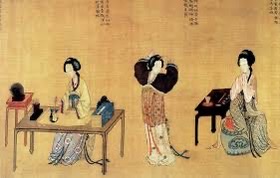Female Entertainers
Part 2
China
Beginning in the 4th century, only men could perform in China’s operatic presentations—even to portray women. During the 7th through 10th centuries, women could sing, dance, do acrobatics, and tell stories in street performances. By the 11th century, neo-Confucianism took hold, which led to a decline in women’s status. When a girl was ten years old, she became homebound and was forbidden to discuss “male matters” in the outside world. By the 13th century, foot binding made women even more downtrodden. Ironically, this cruel practice began with elite dancers, but as the binding became more severe, the women couldn’t dance well—thus female dancing declined.
In the late 13th century, the Mongols overran China and diminished its economy. Women of all classes needed to earn money, and entertaining was one avenue. From the mid-14th through the early 17th century, bound feet or not, more women appeared onstage than ever before—for a while, in fact, more women than men performed. Both male and female actors were considered low class, and sexual services—hetero- and homosexual—often came with the territory.
Coinciding with the rise of female actresses, the upper class treated women as marketable goods whether they were wives, prostitutes, concubines, or courtesans (somewhat similar to Japanese Geishas in that they sang and recited poetry for their customers). Fathers and concubine owners had the power to sell these unfortunates. Worse, female chastity was so highly valued that a rape survivor was expected to commit suicide or submit to murder, and if a woman’s husband died, she was expected to remain chaste for the rest of her life.
By the mid-17th century, men were no longer allowed to sell their wives, concubines, or unmarried daughters. Officials and scholars were expected to prove their commitment to morality by not visiting prostitutes or courtesans in the expensive brothels where women sang and danced.
By the late 19th century, misogyny had taken a downturn. China even had a female ruler, the controversial de facto Empress Dowager Cixi. Due to Christian missionaries and leading Chinese intellectuals who opposed foot binding, it was banned in 1912. Unbound feet were found on only 2.3 percent of girls born before 1910, but 95 percent of those born afterward had unbound feet.
As late as 1913, women remained reluctant to participate in show business. The director considered “the father of Hong Kong Cinema” couldn’t find an actress good enough for his film Zhu Angzi Tests His Wife, and therefore employed his own wife.
Ruan Fenggen, born in 1910, was a silent-film actress since age sixteen. In 1930, at twenty, she was so lauded for her role as a prostitute in Reminiscences of Beijing that she became a major film star. Released in February 1935, her penultimate film, New Women, was about an actress who killed herself. In March 1935, Ruan herself deliberately overdosed on barbiturates. In her alleged suicide note were the words “gossip is a fearful thing,” and her life had certainly been gossip-worthy. Ruan had been married briefly and had supported a spendthrift gambler whom she left in 1933. She then became romantically involved with a tea tycoon who, it was rumored but not proven, had beaten her and forged the suicide note.
The New York Times stated that Ruan had “the most spectacular funeral of the century.” There were 100,000 attendees, including leading actresses, actors, and film directors. In the three-mile-long procession, three women committed suicide. Only months after Ruan’s funeral, her last film was released posthumously.
During China’s Cultural Revolution (1966–’76) Ruan’s tomb was destroyed. In 1991, fifty-six years after her death, Center Stage, an award-winning movie about her, was released in Hong Kong. In 1998 a monument was dedicated to her in Shanghai.

